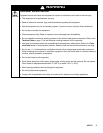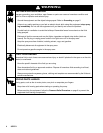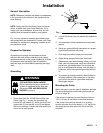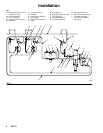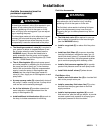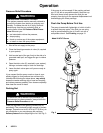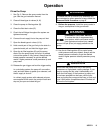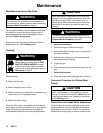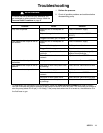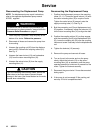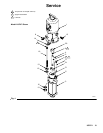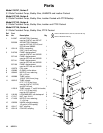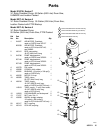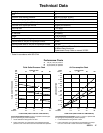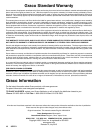
307674 11
Troubleshooting
WARNING
To reduce the risk of serious injury whenever you
are instructed to relieve pressure, always follow the
Pressure Relief Procedure on page 8.
1. Relieve the pressure.
2. Check all possible problems and solutions before
disassembling pump.
Problem
Cause Solution
Pump fails to operate. Restricted line or inadequate air
supply.
Clear; increase air supply.
Dirty or damaged air motor. Service air motor (see 306982 or
307157).
Clogged fluid hose, gun, or nozzle. Clear.*
Pump operates but output is low on
both strokes.
Restricted line or inadequate air
supply.
Clear; increase air supply.
Exhausted fluid supply. Refill; reprime or flush.
Clogged fluid hose, gun, or nozzle. Clear.*
Loose packing nut or worn throat
packings.
Tighten packing nut (see page 8);
replace throat packings.
Piston and intake valves need ad-
justment.
Adjust; see manual 307652.
Pump operates but output is low on
downstroke.
Held open or worn intake valve. Clear; service. See manual 307652.
Pump operates but output is low on
upstroke.
Held open or worn fluid piston valve
or packings.
Clear; service. See manual 307652.
Erratic or accelerated operation. Exhausted fluid supply. Refill; reprime or flush.
Piston and intake valves need ad-
justment.
Adjust; see manual 307652.
Held open or worn intake valve. Clear; service. See manual 307652.
Held open or worn fluid piston valve
or packings.
Clear; service. See manual 307652.
* To determine if the fluid hose or gun is obstructed, follow the Pressure Relief Procedure on page 8. Discon-
nect the fluid hose and place a container at the pump fluid outlet to catch any fluid. Turn on the air just enough to
start the pump (about 20–40 psi [1.4–2.8 bar]). If the pump starts when the air is turned on, the obstruction is in
the fluid hose or gun.



